Life for a judge in the human world can be challenging enough – but life for a judge in Toontown has to be absolutely “trying”. Imagine dealing five days a week with determining the outcome of the frenzied disputes animated characters get into, or their fate when such critters go feloniously over the line. Instead of merely keeping a bench warm, such dispensers of justice must feel as though they’re sitting in the hot seat. No wonder so many presiding magistrates choose the mallet over the gavel – it can become so much more useful when the appropriate opportunity arises. So, settle back in your jury box, and witness again the historic verdicts that have set precedent within the bookworm-infested pages of the dust-covered law books within the Toontown library.
Musicalulu (erroneously retitled “Musical Lulu” on all U. M. & M. TV reprints) (Paramount/Famous, Little Lulu, 1/24/47 – I. Sparber, dir.) – Lulu had her first brief but notable “daydream” sequence in her first Paramount appearance in “Eggs Don’t Bounce” (1943). By the time of this production, the dream was developing as a “go to” formula for the Paramount writers so as to envelop entire episodes. Other Lulu cartoons had before and would later follow the formula, including “Lulu’s Birthday Party”, “Beau Ties”, “Bored of Education”. “A Bout With a Trout”, “Super Lulu”, and “The Baby Sitter” – and it would be virtually milked to death with the coming of Little Audrey, one of which will be reviewed later in this article series.
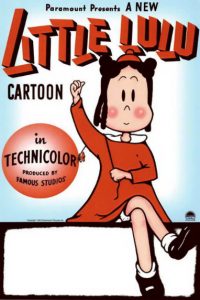 Here, the starting premise is Lulu torn between the boredom of practicing her violin lessons and a baseball game being organized by Tubby outside. Knowing her father expects her to practice for a good half hour yet, she solves the problem by subterfuge – tying the violin bow to the tail of her dog, and giving him a bone so that his tail wags the bow across the violin strings. Lulu plays outfield in the game, but a fly ball catches in the rain gutter of the house, then unexpectedly conks Lulu on the head. Amidst a spiral of stars, Lulu is transported to a surreal world of living musical instruments, where a bass drum “cop” places her in handcuffs and hauls her in to the Musical Court of Justice (housed in a giant juke box). There, before a jury of 8 violins (another odd number for jury impanelment – but more economic than animating 12) in a jury box made of a grand piano, she is placed on trial for desertion of her instrument. A prosecuting attorney (a clarinet) presents his case before a bass fiddle judge sitting at a conductor’s podium on a kettle drum chair. A court reporter (a harmonica) takes down “notes” in shorthand on music sheets. The prosecutor presents compelling evidence – Lulu’s violin, displaying broken strings, and Lulu’s incriminating name carved with a penknife into her backside. Lulu tries her own influence on the jury – making distorted faces at the prosecutor through a bubble blown with bubble gum, displaying a bare “rubber hose” feminine leg (causing the jury to react “Woo Woo”), and slingshooting a cork into the prosecutor’s “bell” opening, temporarily silencing him. But the final blow comes when the prosecutor produces a surprise corroborating witness who claims to have seen the whole thing. Lulu denounces him: “He’s a lyre – an awful lyre!” But to no avail, as the violins unanimously hold up their bows in a verdict of “Guilty!!!”, the bows mirroring the prison bars Lulu will soon be behind.
Here, the starting premise is Lulu torn between the boredom of practicing her violin lessons and a baseball game being organized by Tubby outside. Knowing her father expects her to practice for a good half hour yet, she solves the problem by subterfuge – tying the violin bow to the tail of her dog, and giving him a bone so that his tail wags the bow across the violin strings. Lulu plays outfield in the game, but a fly ball catches in the rain gutter of the house, then unexpectedly conks Lulu on the head. Amidst a spiral of stars, Lulu is transported to a surreal world of living musical instruments, where a bass drum “cop” places her in handcuffs and hauls her in to the Musical Court of Justice (housed in a giant juke box). There, before a jury of 8 violins (another odd number for jury impanelment – but more economic than animating 12) in a jury box made of a grand piano, she is placed on trial for desertion of her instrument. A prosecuting attorney (a clarinet) presents his case before a bass fiddle judge sitting at a conductor’s podium on a kettle drum chair. A court reporter (a harmonica) takes down “notes” in shorthand on music sheets. The prosecutor presents compelling evidence – Lulu’s violin, displaying broken strings, and Lulu’s incriminating name carved with a penknife into her backside. Lulu tries her own influence on the jury – making distorted faces at the prosecutor through a bubble blown with bubble gum, displaying a bare “rubber hose” feminine leg (causing the jury to react “Woo Woo”), and slingshooting a cork into the prosecutor’s “bell” opening, temporarily silencing him. But the final blow comes when the prosecutor produces a surprise corroborating witness who claims to have seen the whole thing. Lulu denounces him: “He’s a lyre – an awful lyre!” But to no avail, as the violins unanimously hold up their bows in a verdict of “Guilty!!!”, the bows mirroring the prison bars Lulu will soon be behind.
The remainder of the film centers around Lulu’s attempt at a prison break. Imprisoned in a large guitar with the six strings as bars, she stretches two of the strings backward, and is catapulted free out the sound hole. But her nightmare has just begun, as a quartet of quarter notes block her path, and taunt her with an original song, “You Gotta Have Music”. A fantasy chase ensues, with Lulu pursued across a giant piano keyboard, nearly crushed by huge cymbals, snapped at by a serpentine concertina, blown skyward by a chorus of trumpets, and finally ensnared in harp strings like a spider’s web. The scene spirals, as Lulu returns to consciousness and the real world. Thinking better of abandoning her violin, she races in the house and retrieves it from her dog’s tail. But clever Lulu devises a solution to obtain the best of both worlds. She practices her lesson – but on the baseball diamond, using the instrument as her custom bat to sock a homer between cadenzas.
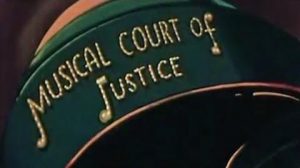 Sadly, this film has seen irreparable damage, dating back to its first issuance to television. A major soundtrack break apparently occurred in the master negatives (UCLA, who generally reports having only one soundtrack source for each Paramount cartoon of the period, shows holdings on this title of only a dubbed duplicate soundtrack negative, with the original presumably having been lost or destroyed), in which eleven notes of vocal music (following an ascending and descending eight-note scale) were lost from the middle of the “You Gotta Have Music” number. While a recent internet post has left a silence where the eleven notes should have been, all original U. M.& M. prints offered the ridiculous solution of allowing the soundtrack to play through unaltered with its splice in place, yet presenting the picture elements intact – meaning that the last two minutes of the cartoon have always been seen entirely out-of-sync! I’ve attempted below a compromise version between the two extremes – resynchronizing the two minute ending, and inserting in the silence a best-effort (though far from perfect) attempt to recreate the eleven missing notes in the original chorus’s own voices – a sort of patchwork quilt reversing the order of some notes from the downhill scale into the corresponding uphill one, and filling the entirely lost notes with bits of syllables from other parts of the chorus’s performances – both from this cartoon and from a companion piece, “You’ve Got the Tummy-Ache Blues” presented in Little Audrey’s starring debut in Butterscotch and Soda (1948). I’ve also added some Paramount titling in the places where it could be matched from other films (though the original art cards have to date never turned up). It was grueling work, and may not be entirely satisfying – but at least it gives a rough idea of the music as it should have been originally presented. If anyone can do it better, feel free to show me up!
Sadly, this film has seen irreparable damage, dating back to its first issuance to television. A major soundtrack break apparently occurred in the master negatives (UCLA, who generally reports having only one soundtrack source for each Paramount cartoon of the period, shows holdings on this title of only a dubbed duplicate soundtrack negative, with the original presumably having been lost or destroyed), in which eleven notes of vocal music (following an ascending and descending eight-note scale) were lost from the middle of the “You Gotta Have Music” number. While a recent internet post has left a silence where the eleven notes should have been, all original U. M.& M. prints offered the ridiculous solution of allowing the soundtrack to play through unaltered with its splice in place, yet presenting the picture elements intact – meaning that the last two minutes of the cartoon have always been seen entirely out-of-sync! I’ve attempted below a compromise version between the two extremes – resynchronizing the two minute ending, and inserting in the silence a best-effort (though far from perfect) attempt to recreate the eleven missing notes in the original chorus’s own voices – a sort of patchwork quilt reversing the order of some notes from the downhill scale into the corresponding uphill one, and filling the entirely lost notes with bits of syllables from other parts of the chorus’s performances – both from this cartoon and from a companion piece, “You’ve Got the Tummy-Ache Blues” presented in Little Audrey’s starring debut in Butterscotch and Soda (1948). I’ve also added some Paramount titling in the places where it could be matched from other films (though the original art cards have to date never turned up). It was grueling work, and may not be entirely satisfying – but at least it gives a rough idea of the music as it should have been originally presented. If anyone can do it better, feel free to show me up!
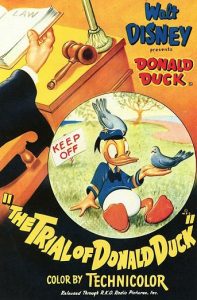 The Trial of Donald Duck (Disney/RKO, Donald Duck, 7/30/48 -Jack King, dir.). With the traditional bang of gavel, the case of “Pierre v. Duck” is called from the bench. As this appears to be a criminal prosecution, toon justice again strangely wastes no time with captioning the case, “People vs. Duck”, nor with presentations by a prosecuting attorney. Instead, as in “The Trial of Mr. Wolf”, previously briefed in this series, we are immediately placed into the capable hands of a human defense attorney, who uses proper courtroom lingo (“May it please the court”), and pronounces that he intends to prove his client, D. Duck, innocent. Mr. Duck enters the room, well prepped by his counsel (a rarity in good lawyering for an animated venue!), putting on his most appealing demeanor, with a wide smile and best-behavior stride that utterly begs for an angel’s halo to appear above his head. A bailiff thrusts the bible into his beak, and utters a garbled version of the oath to Donald (featuring the phrase “so help me Hannah” – a second time this phrase was used by Jack King, previously in “Cured Duck” (1945), taking an unusual nod to the man who was fast becoming King’s duck rival and ultimately successor, Jack Hannah). Without ever having the opportunity to affirm the oath verbally, Donald raises his right hand, but notably keeps his fingers crossed. In stoic solemnity, defense counsel states, “May the light of truth guide us to find the innocent.” He is forced to repeat the phrase “light of truth” with some insistency, engaging in a bit of prohibited “witness coaching”, prompting Donald to tug with his foot upon the curtain cord of a window high above the witness chair, opening the blinds to send a heavenly ray of sunlight streaming down upon his countenance. As the counsel continues to build up the character of his client as “kind, loving, and gentle”, Donald effeminately bats his eyelashes, grins a bashful grin, then oddly chooses the opportunity to pull out a handkerchief to blow his nose as if to fight back tears, only to produce underneath it a concealed bean-shooter to blow at the person pressing charges – a tuxedo-wearing Frenchman “stuffed shirt” of a restaurant proprietor, Pierre. Donald’s shot sends the Frenchman into a pounding fit upon the box railing, while defense counsel uses the opportunity to verbally paint him as a “hardened soul” who shall be “unmasked”. The judge calls for order and for a statement of the facts. In an unusual (but effective) violation of the rules of evidence, counsel is permitted to present a summation of evidence rather than testimony under oath of his client (though the Duck is sitting right there, and has at no time visibly pleaded the Fifth Amendment – oh, well, better than leaving it to the court reporter to attempt to transcribe the Duck’s words without an interpreter).
The Trial of Donald Duck (Disney/RKO, Donald Duck, 7/30/48 -Jack King, dir.). With the traditional bang of gavel, the case of “Pierre v. Duck” is called from the bench. As this appears to be a criminal prosecution, toon justice again strangely wastes no time with captioning the case, “People vs. Duck”, nor with presentations by a prosecuting attorney. Instead, as in “The Trial of Mr. Wolf”, previously briefed in this series, we are immediately placed into the capable hands of a human defense attorney, who uses proper courtroom lingo (“May it please the court”), and pronounces that he intends to prove his client, D. Duck, innocent. Mr. Duck enters the room, well prepped by his counsel (a rarity in good lawyering for an animated venue!), putting on his most appealing demeanor, with a wide smile and best-behavior stride that utterly begs for an angel’s halo to appear above his head. A bailiff thrusts the bible into his beak, and utters a garbled version of the oath to Donald (featuring the phrase “so help me Hannah” – a second time this phrase was used by Jack King, previously in “Cured Duck” (1945), taking an unusual nod to the man who was fast becoming King’s duck rival and ultimately successor, Jack Hannah). Without ever having the opportunity to affirm the oath verbally, Donald raises his right hand, but notably keeps his fingers crossed. In stoic solemnity, defense counsel states, “May the light of truth guide us to find the innocent.” He is forced to repeat the phrase “light of truth” with some insistency, engaging in a bit of prohibited “witness coaching”, prompting Donald to tug with his foot upon the curtain cord of a window high above the witness chair, opening the blinds to send a heavenly ray of sunlight streaming down upon his countenance. As the counsel continues to build up the character of his client as “kind, loving, and gentle”, Donald effeminately bats his eyelashes, grins a bashful grin, then oddly chooses the opportunity to pull out a handkerchief to blow his nose as if to fight back tears, only to produce underneath it a concealed bean-shooter to blow at the person pressing charges – a tuxedo-wearing Frenchman “stuffed shirt” of a restaurant proprietor, Pierre. Donald’s shot sends the Frenchman into a pounding fit upon the box railing, while defense counsel uses the opportunity to verbally paint him as a “hardened soul” who shall be “unmasked”. The judge calls for order and for a statement of the facts. In an unusual (but effective) violation of the rules of evidence, counsel is permitted to present a summation of evidence rather than testimony under oath of his client (though the Duck is sitting right there, and has at no time visibly pleaded the Fifth Amendment – oh, well, better than leaving it to the court reporter to attempt to transcribe the Duck’s words without an interpreter).
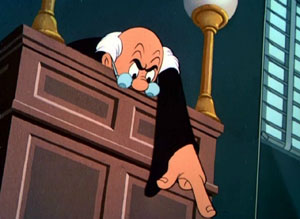 The counsel recounts the events of Septober Umpteen, as Donald sits peacefully in a public park feeding pigeons from items in his lunch box. A sudden rain shower causes him to take cover under the awning of Café Chez Pierre. Donald thinks of obtaining a cup of coffee, and enters the establishment, with finances on his person consisting of one nickel. The interior is a swank society eatery, with Pierre personally presiding as maitre d. Donald is ushered to a table, where candlelight is lit, and a wide variety of silverware is spread before him. Donald fails to note a small placard at the candle’s base, reading “Cover Charge – $5.00″, so we already know he’s in trouble. Pierre claps a signal to an orchestra , which strikes up salon-style background music. Ignoring the indecipherable French menu recommendations of Pierre, Donald requests coffee. “Demitasse?” asks Pierre. “Java”, replies Donald. Pierre exits to the kitchen, while Donald busies himself by attempting to polish spots off the silverware. Pierre return with a cup so small, Donald’s eyes widen to a dimension three times the cup’s diameter. The cup is “filled” by what amounts to a spit out the spout of Pierre’s pot. Finding only the single drop for his serving, Donald begins to show his true colors, leaping onto Pierre’s chest. “Hey, where’s my coffee? I’ll call the cops. I’ll crucify ya!” Pierre attempts to maintain his cool and is apologetic. But while waiting for a refill, a frustrated Donald thrusts away the silverware and plate, and instead spreads out the contents of his lunch box across the table. “What is thees!!”, shouts Pierre. “Monsieur, we cannot allow…” Then Pierre pauses. “Or can we?” Glancing over Donald’s table, he adds to the bill for coffee a charge for every item Donald has brought for lunch – as if Pierre had served them himself. Pierre leaves the check on Donald’s table – for a whopping $35.99! Donald, with only his nickel, pleads for reasonableness from Pierre, but finds him cold (transforming into an ice statue) and hard (transforming into stone). Defense counsel states that Donald, with “magnificent restraint”, voiced a “timid protest” – in fact, the long-awaited trademark temper tantrum. But Pierre wraps him up in the tablecloth, and hands him over to the authorities. From behind a railing resembling prison bars, the camera returns to view of Donald in the courtroom. As Pierre is fingered by the counsel as the “real culprit”, Pierre objects. Ignoring all formality, the judge rules, “Shut up!” Counsel throws himself and Donald upon “the mercy of the court”. Verdict is rendered from the bench – ten dollars or ten days washing dishes – or else. Now the judge illustrates with the window’s Venetian blinds, readjusting them to cast prison stripes across Donald’s shirt. Not having the ten dollars, Donald opts for the dishwashing gig. However, Pierre quickly learns that his hard-fought vengeance was a mistake – as Donald gingerly engages in breaking every dish he encounters. Pierre begs with Donald, forgiving him, offering to pay him, and feed him, if he’ll please stop washing dishes. “You heard what the judge said! TEN DAYS!” shouts Donald, as the plates continue to fall amidst Pierre’s hopeless moans, for the iris out. (Notably, the setup for this film would be well remembered by other studios, with Woody Woodpecker also ordering coffee in a French restaurant in A Fine Feathered Frenzy (1954), and Yogi Bear as a “good will ambassador”, causing an international incident by smothering a French chef’s creation in tomato catsup, in A Bear Pair (1961).)
The counsel recounts the events of Septober Umpteen, as Donald sits peacefully in a public park feeding pigeons from items in his lunch box. A sudden rain shower causes him to take cover under the awning of Café Chez Pierre. Donald thinks of obtaining a cup of coffee, and enters the establishment, with finances on his person consisting of one nickel. The interior is a swank society eatery, with Pierre personally presiding as maitre d. Donald is ushered to a table, where candlelight is lit, and a wide variety of silverware is spread before him. Donald fails to note a small placard at the candle’s base, reading “Cover Charge – $5.00″, so we already know he’s in trouble. Pierre claps a signal to an orchestra , which strikes up salon-style background music. Ignoring the indecipherable French menu recommendations of Pierre, Donald requests coffee. “Demitasse?” asks Pierre. “Java”, replies Donald. Pierre exits to the kitchen, while Donald busies himself by attempting to polish spots off the silverware. Pierre return with a cup so small, Donald’s eyes widen to a dimension three times the cup’s diameter. The cup is “filled” by what amounts to a spit out the spout of Pierre’s pot. Finding only the single drop for his serving, Donald begins to show his true colors, leaping onto Pierre’s chest. “Hey, where’s my coffee? I’ll call the cops. I’ll crucify ya!” Pierre attempts to maintain his cool and is apologetic. But while waiting for a refill, a frustrated Donald thrusts away the silverware and plate, and instead spreads out the contents of his lunch box across the table. “What is thees!!”, shouts Pierre. “Monsieur, we cannot allow…” Then Pierre pauses. “Or can we?” Glancing over Donald’s table, he adds to the bill for coffee a charge for every item Donald has brought for lunch – as if Pierre had served them himself. Pierre leaves the check on Donald’s table – for a whopping $35.99! Donald, with only his nickel, pleads for reasonableness from Pierre, but finds him cold (transforming into an ice statue) and hard (transforming into stone). Defense counsel states that Donald, with “magnificent restraint”, voiced a “timid protest” – in fact, the long-awaited trademark temper tantrum. But Pierre wraps him up in the tablecloth, and hands him over to the authorities. From behind a railing resembling prison bars, the camera returns to view of Donald in the courtroom. As Pierre is fingered by the counsel as the “real culprit”, Pierre objects. Ignoring all formality, the judge rules, “Shut up!” Counsel throws himself and Donald upon “the mercy of the court”. Verdict is rendered from the bench – ten dollars or ten days washing dishes – or else. Now the judge illustrates with the window’s Venetian blinds, readjusting them to cast prison stripes across Donald’s shirt. Not having the ten dollars, Donald opts for the dishwashing gig. However, Pierre quickly learns that his hard-fought vengeance was a mistake – as Donald gingerly engages in breaking every dish he encounters. Pierre begs with Donald, forgiving him, offering to pay him, and feed him, if he’ll please stop washing dishes. “You heard what the judge said! TEN DAYS!” shouts Donald, as the plates continue to fall amidst Pierre’s hopeless moans, for the iris out. (Notably, the setup for this film would be well remembered by other studios, with Woody Woodpecker also ordering coffee in a French restaurant in A Fine Feathered Frenzy (1954), and Yogi Bear as a “good will ambassador”, causing an international incident by smothering a French chef’s creation in tomato catsup, in A Bear Pair (1961).)
 A Mutt In a Rut (Paramount/Famous, Noveltoon, 5/27/49 – I. Sparber, dir.) – The Mutt (Dog Face) faces trial in a similar manner to Pluto in Pluto’s Judgment Day. On a snowy winter night, Dog Face’s master admits a kitten in from the storm, who starts things out on the wrong foot with Dog Face by shaking off snow onto him in the middle of the dog’s warm nap in front of the fireplace. Next thing the dog knows, his master is feeding milk to the kitten out of Dog Face’s bowl. Dog Face tries to get even by flipping the bowl upside down onto the kitten, but is caught in the act by the master for a stern reprimand. Next, the kitten is placed in Dog Face’s personal rocking cradle bed. As soon as the master steps away, Dog Face kicks the cradle, knocking the kitten out, and assumes the kitten’s place under the blanket. But again the master intervenes, and Dog Face is left to sulk. “I wish I were dead”, he mutters. At that moment, the kitten chases a ball that has bounced into a heavy vase on a pedestal. Dog Face lunges at the cat, upsetting the pedestal, and causing the vase to fall on himself, knocking him cold. From his back, a zipper opens, and a transparent form of himself exits, departing in a winged elevator which appears from nowhere, headed for Dog Heaven. Peering through the gates of his destination, Dog Face sees a huge plate loaded with steaks flown in by an angel chef for the occupants’ communal dinner. Dog Face tunnels under the gates, and starts piling steaks high for a tasty meal, when along comes a bulldog angel in a policeman’s uniform, riding a motorcycle cloud. “Where are your wings?” demands the bulldog.
A Mutt In a Rut (Paramount/Famous, Noveltoon, 5/27/49 – I. Sparber, dir.) – The Mutt (Dog Face) faces trial in a similar manner to Pluto in Pluto’s Judgment Day. On a snowy winter night, Dog Face’s master admits a kitten in from the storm, who starts things out on the wrong foot with Dog Face by shaking off snow onto him in the middle of the dog’s warm nap in front of the fireplace. Next thing the dog knows, his master is feeding milk to the kitten out of Dog Face’s bowl. Dog Face tries to get even by flipping the bowl upside down onto the kitten, but is caught in the act by the master for a stern reprimand. Next, the kitten is placed in Dog Face’s personal rocking cradle bed. As soon as the master steps away, Dog Face kicks the cradle, knocking the kitten out, and assumes the kitten’s place under the blanket. But again the master intervenes, and Dog Face is left to sulk. “I wish I were dead”, he mutters. At that moment, the kitten chases a ball that has bounced into a heavy vase on a pedestal. Dog Face lunges at the cat, upsetting the pedestal, and causing the vase to fall on himself, knocking him cold. From his back, a zipper opens, and a transparent form of himself exits, departing in a winged elevator which appears from nowhere, headed for Dog Heaven. Peering through the gates of his destination, Dog Face sees a huge plate loaded with steaks flown in by an angel chef for the occupants’ communal dinner. Dog Face tunnels under the gates, and starts piling steaks high for a tasty meal, when along comes a bulldog angel in a policeman’s uniform, riding a motorcycle cloud. “Where are your wings?” demands the bulldog.
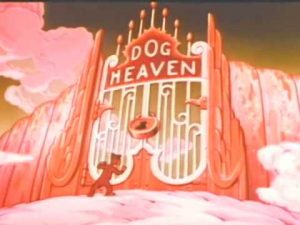 “Well, you see, officer, I, uh…” stammers Dog Face. “Well that’s what they all say”, snaps the bulldog in Irish brogue. “Just ye be tellin’ it to St. Bernard.” At the Dog Heaven court of justice, we hear the honorable St. Bernard repeating his oath of office – “And it shall be my duty as judge of this court to prosecute to the limit of the law all dogs accused of crimes perpetrated on Earth.” The arresting officer accuses Dog Face of being no angel. The judge looks up the accused’s record in a book. Clearing his throat, the judge in doubletalk states that Dog Face “has ignored all laws pertaining to illegaseptifice and also with persaperbole intermaterating the ipso facto of the peteremus of the first part of the second part” – in other words, “Felineous assault”. After uttering all these syllables, the judge’s mouth is apparently dry, and, being a St. Bernard, he engages in a practice not recommended for judicial officers – drinking while on duty from his brandy barrel. The judge turns the decision over to the jury – a twelve member panel of kittens. A unanimous “Guilty” is issued without so much as a deliberation. “Have you anything to say before sentence is passed upon you?”, asks the Judge. “Why, yes, your honor, I – – “, begins Dog Face. As Dog Face leans toward the bench, the judge slams shut his huge record book, squarely upon Dog Face’s head, announcing, “The case is closed!” A fiery elevator with doorway like a mouth barred with toothy fangs swallows up Dog Face, and transports him to the “other place”. Dog Face’s harrowing encounter with the underworld has been previously documented in my “Go To Hades” series in early Animation Trails posts on this website, to which the reader is directed for further detail. Needless to say, Dog Face eventually awakens as did Pluto before the fireplace, and makes amends by rocking the kitten in his cradle and feeding him alternating courses of ice cream and cake.
“Well, you see, officer, I, uh…” stammers Dog Face. “Well that’s what they all say”, snaps the bulldog in Irish brogue. “Just ye be tellin’ it to St. Bernard.” At the Dog Heaven court of justice, we hear the honorable St. Bernard repeating his oath of office – “And it shall be my duty as judge of this court to prosecute to the limit of the law all dogs accused of crimes perpetrated on Earth.” The arresting officer accuses Dog Face of being no angel. The judge looks up the accused’s record in a book. Clearing his throat, the judge in doubletalk states that Dog Face “has ignored all laws pertaining to illegaseptifice and also with persaperbole intermaterating the ipso facto of the peteremus of the first part of the second part” – in other words, “Felineous assault”. After uttering all these syllables, the judge’s mouth is apparently dry, and, being a St. Bernard, he engages in a practice not recommended for judicial officers – drinking while on duty from his brandy barrel. The judge turns the decision over to the jury – a twelve member panel of kittens. A unanimous “Guilty” is issued without so much as a deliberation. “Have you anything to say before sentence is passed upon you?”, asks the Judge. “Why, yes, your honor, I – – “, begins Dog Face. As Dog Face leans toward the bench, the judge slams shut his huge record book, squarely upon Dog Face’s head, announcing, “The case is closed!” A fiery elevator with doorway like a mouth barred with toothy fangs swallows up Dog Face, and transports him to the “other place”. Dog Face’s harrowing encounter with the underworld has been previously documented in my “Go To Hades” series in early Animation Trails posts on this website, to which the reader is directed for further detail. Needless to say, Dog Face eventually awakens as did Pluto before the fireplace, and makes amends by rocking the kitten in his cradle and feeding him alternating courses of ice cream and cake.
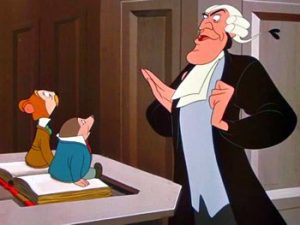 The Wind In the Willows element of Disney’s “double feature”, The Adventures of Ichabod and Mr. Toad (10/5/49), presents British justice at its most Dickensian cruel, and a fine lesson in how to frame a “pigeon” ready for the plucking. Toad is put on trial for being discovered driving a stolen “motor car”. Proving the old adage that anyone who represents himself in court has a fool for a client, Toad rises with traditional powdered wig, ready to plead his own defense. He calls as first witness his faithful friend and carriage horse, Cyril Proudbottom. The prosecuting attorney attempts pressure tactics to get Cyril to say something incriminating about his master, but Cyril insists that Toad got the motor car “the honest way”. “And what is the honest way?” the prosecutor sneers. “Ha Ha. I thought y’wouldn’t know that, Guv’nor!”, wisecracks Cyril. Allowed by the judge to tell the story as a narrative (an approach rarely approved by any practicing attorney, as most witnesses will inevitably “shoot their mouth off” with too much information if not restricted to a “questions and answers” format), Cyril narrates how Toad, although having his funds cut off, fell in love with the little red motor car and tracked it to a tavern.
The Wind In the Willows element of Disney’s “double feature”, The Adventures of Ichabod and Mr. Toad (10/5/49), presents British justice at its most Dickensian cruel, and a fine lesson in how to frame a “pigeon” ready for the plucking. Toad is put on trial for being discovered driving a stolen “motor car”. Proving the old adage that anyone who represents himself in court has a fool for a client, Toad rises with traditional powdered wig, ready to plead his own defense. He calls as first witness his faithful friend and carriage horse, Cyril Proudbottom. The prosecuting attorney attempts pressure tactics to get Cyril to say something incriminating about his master, but Cyril insists that Toad got the motor car “the honest way”. “And what is the honest way?” the prosecutor sneers. “Ha Ha. I thought y’wouldn’t know that, Guv’nor!”, wisecracks Cyril. Allowed by the judge to tell the story as a narrative (an approach rarely approved by any practicing attorney, as most witnesses will inevitably “shoot their mouth off” with too much information if not restricted to a “questions and answers” format), Cyril narrates how Toad, although having his funds cut off, fell in love with the little red motor car and tracked it to a tavern.
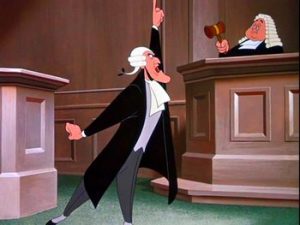 There he meets its “owners” (a pack of weasels) and a barman named Winky, and strikes a deal, allegedly witnessed by Winky, to trade the weasels in return for the motor car the one thing of value Toad still has – signing over a deed to his entire ancestral estate, Toad Hall! No one, least of all the prosecuting attorney, believes the story, or that anyone would give away an estate for a motor car. Toad remains confident, announcing that he can produce an impartial witness, and calls to the stand Winky. Here Toad commits the procedural errors of a lifetime: (1) not knowing in advance precisely what his witness is going to say through advance preparation, and (2) building up before the court the character references of his witness as so upstanding as to render him of “unimpeachable honesty”. Winky (who is in fact in league with and leader of the band of weasels) testifies to having witnessed an incident in his establishment that Toad was a party to. Toad, already wending his way to the courthouse door as if about to step out to freedom, casually asks Winky to describe in his own words the incident (Ah, the danger of narrative testimony again). “Well, Guv’nor,” replies Winky, “you tried to sell me a stolen motor car!”. The courtroom door is slammed shut in Toad’s face, and the guilty verdict is sure and swift. This film should be reissued in the Disney instructional series, as a primer to attorneys and litigants alike on how not to conduct your trial.
There he meets its “owners” (a pack of weasels) and a barman named Winky, and strikes a deal, allegedly witnessed by Winky, to trade the weasels in return for the motor car the one thing of value Toad still has – signing over a deed to his entire ancestral estate, Toad Hall! No one, least of all the prosecuting attorney, believes the story, or that anyone would give away an estate for a motor car. Toad remains confident, announcing that he can produce an impartial witness, and calls to the stand Winky. Here Toad commits the procedural errors of a lifetime: (1) not knowing in advance precisely what his witness is going to say through advance preparation, and (2) building up before the court the character references of his witness as so upstanding as to render him of “unimpeachable honesty”. Winky (who is in fact in league with and leader of the band of weasels) testifies to having witnessed an incident in his establishment that Toad was a party to. Toad, already wending his way to the courthouse door as if about to step out to freedom, casually asks Winky to describe in his own words the incident (Ah, the danger of narrative testimony again). “Well, Guv’nor,” replies Winky, “you tried to sell me a stolen motor car!”. The courtroom door is slammed shut in Toad’s face, and the guilty verdict is sure and swift. This film should be reissued in the Disney instructional series, as a primer to attorneys and litigants alike on how not to conduct your trial.
Don’t have the scene for you – but here is the films’s rarely seen original trailer:
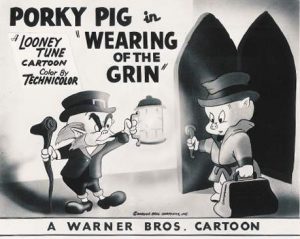 The Wearing of the Grin (Warner, Porky Pig, 7/14/51 – Charles M. (Chuck) Jones, dir,) – Traveling salesman Porky Pig is caught in a tumultuous storm while trekking the back country of the Emerald Isle. Seeking shelter at a “quaint old castle”, Porky receives a blow to the head from a mace jostled loose from above the castle door. When he seemingly comes to, he soon learns that he has stumbled upon a castle deserted except for two leprechauns, one of them being the leprechaun king. Diving under the covers of a Murphy bed, Porky is ejected by the bed folding inrto the wall, dropping Porky into a hidden tunnel, and into the chambers of a subterranean courtroom. One leprechaun acts as bailiff, announcing, “Hear ye! Hear ye! The leprechaun court of O’Shaunnessy Township, County of Rourke O’Houlahan, is now in session. The little People (finally, someone gets the caption for a criminal prosecution right) vs. Porky Pig, for attempting to steal the pot o’ gold.” The pot sits prominentlt before the bench as prosecution Exhibit “A”. “B-b-but that’s silly”, begins Porky, “I didn’t…” “Silence in the courtroom, ye blatherskite”, shouts the bailiff, whacking Porky on the head with a shillelagh. “The right honorable Judge O’Pat presiding”, the bailiff continues, as the leprechaun king enters, bedecked in robe and powdered wig. One look by the judge at Porky, and verdict is declared without evidentiary presentation: “Guilty as the day is long.” Porky attempts to protest, demanding a fair trial, but is silenced by another shillelagh blow from the bailiff. “I sentence ye to the wearin’ of the green shoes”, declares the judge. The bailiff exits, returning with a pair of bright green boots, whicg are tied onto Porky’s ankles. A surprised Porky comments “I’m afraid I had you fellas all wrong. Why they’re the nicest shoes I ever – – I ever – -“ His voice trails off to an “I – yi – yi – yi -yi – -“ as the shoes begin dancing an Irish jig under their own power, carrying him helplessly away over a stylized Irish countryside, as the echoing laughter of the leprechauns dominates the soundtrack. Porky’s nightmare encounter in his dancing frenzy with virtually everything symbolically Irish is related in another of my previous posts, “Beware the Leprechauns!”, from last St. Patty’s Day. Ultimately, Porky, as did Dog Face, comes to, and heads for the hills, and for an appointment with the nearest psychiatrist he can find, while the caretaker of the castle turns out to be the two leprechauns standing on each other’s shoulders after all, for a clover-shaped iris out.
The Wearing of the Grin (Warner, Porky Pig, 7/14/51 – Charles M. (Chuck) Jones, dir,) – Traveling salesman Porky Pig is caught in a tumultuous storm while trekking the back country of the Emerald Isle. Seeking shelter at a “quaint old castle”, Porky receives a blow to the head from a mace jostled loose from above the castle door. When he seemingly comes to, he soon learns that he has stumbled upon a castle deserted except for two leprechauns, one of them being the leprechaun king. Diving under the covers of a Murphy bed, Porky is ejected by the bed folding inrto the wall, dropping Porky into a hidden tunnel, and into the chambers of a subterranean courtroom. One leprechaun acts as bailiff, announcing, “Hear ye! Hear ye! The leprechaun court of O’Shaunnessy Township, County of Rourke O’Houlahan, is now in session. The little People (finally, someone gets the caption for a criminal prosecution right) vs. Porky Pig, for attempting to steal the pot o’ gold.” The pot sits prominentlt before the bench as prosecution Exhibit “A”. “B-b-but that’s silly”, begins Porky, “I didn’t…” “Silence in the courtroom, ye blatherskite”, shouts the bailiff, whacking Porky on the head with a shillelagh. “The right honorable Judge O’Pat presiding”, the bailiff continues, as the leprechaun king enters, bedecked in robe and powdered wig. One look by the judge at Porky, and verdict is declared without evidentiary presentation: “Guilty as the day is long.” Porky attempts to protest, demanding a fair trial, but is silenced by another shillelagh blow from the bailiff. “I sentence ye to the wearin’ of the green shoes”, declares the judge. The bailiff exits, returning with a pair of bright green boots, whicg are tied onto Porky’s ankles. A surprised Porky comments “I’m afraid I had you fellas all wrong. Why they’re the nicest shoes I ever – – I ever – -“ His voice trails off to an “I – yi – yi – yi -yi – -“ as the shoes begin dancing an Irish jig under their own power, carrying him helplessly away over a stylized Irish countryside, as the echoing laughter of the leprechauns dominates the soundtrack. Porky’s nightmare encounter in his dancing frenzy with virtually everything symbolically Irish is related in another of my previous posts, “Beware the Leprechauns!”, from last St. Patty’s Day. Ultimately, Porky, as did Dog Face, comes to, and heads for the hills, and for an appointment with the nearest psychiatrist he can find, while the caretaker of the castle turns out to be the two leprechauns standing on each other’s shoulders after all, for a clover-shaped iris out.
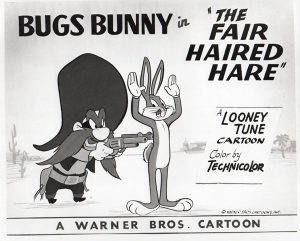 The Fair Haired Hare (Warner, Bugs Bunny, 4/14/51 – I. (Friz) Freleng, dir.). Only in the world of Looney Tunes could a property dispute become this bizarre. Bugs enjoys a peaceful existence on the prairie, strumming a guitar in his rabbit hole, as he sings about the land “where the deer and the antelope play – and the rabbits.” Abruptly, the sunlight is blocked off from his rabbit hole by the wood paneling of floorboards, as a construction crew builds in the twinkling of an eye a brand new sprawling ranch-style home directly across Bugs’s property. Furniture is unloaded from a van with one tilt, in the style of a dunp truck, and Yosemite Sam moves in, strumming a banjo to a tune borrowed from Daffy Duck in A Coy Decoy – “Oh I can’t get a long little doggie. No I can’t even get one that’s small.” Bugs pounds from below the floorboards, but Sam dismisses the pounding as “Mice”. Bugs finds a saw and cuts himself an exit hole – which happens to place him directly under a bearskin rug in the living room, Bugs emerging out of the bear’s jaws. The jaws close on Bugs, and Bugs drags himself and the rug around the living room, shouting for help and attempting to beat off the ferocious beast. Sam is fooled too by the sight of this spectacle, and pulls out his six shooters, firing away at the rug. “Playin’ possum for twenty years – – That’ll learn ya!” Despite seemingly saving Bugs’ life, Sam is no kinder to Bugs than to the bear, ordering him to haul his carcass off of Sam’s property. Bugs protests that Sam can’t get away with it, and, dodging a hail of bullets, shouts that he’ll take his property claim to the highest court in the land. The scene changes to a mountain trail leading to a remote courthouse on a high peak, elevation 6723 feet. ”I shoulda picked a lower court”, wheezes a panting Bugs trudging up the path. “I’m bushed.” The case comes up for trial, and a judge issues his ruling – a verdict that defies all principles and precedents of real estate law. Instead of one or the other party getting a fee simple estate and quiet title rights against the other, the judge declares both of the litigants to be joint tenants – sharing an equal right to possession! (That kind of ruling is sure to set title insurers’ heads spinning.) To make matters worse, the judge doesn’t just award a mere right to possession, but orders that Bugs and Sam “both share this property under the same roof”! (For the second time in this series of articles, one wonders if Friz Freleng knew a single thing about law, or simply made it up as he goes.) And as with such forms of common ownership, a survivorship provision is included – upon the passing one tenant, all of his rights revert to the other. Bugs can see the handwriting on the wall from this proviso, as Sam snickers menacingly and the scene fades out.
The Fair Haired Hare (Warner, Bugs Bunny, 4/14/51 – I. (Friz) Freleng, dir.). Only in the world of Looney Tunes could a property dispute become this bizarre. Bugs enjoys a peaceful existence on the prairie, strumming a guitar in his rabbit hole, as he sings about the land “where the deer and the antelope play – and the rabbits.” Abruptly, the sunlight is blocked off from his rabbit hole by the wood paneling of floorboards, as a construction crew builds in the twinkling of an eye a brand new sprawling ranch-style home directly across Bugs’s property. Furniture is unloaded from a van with one tilt, in the style of a dunp truck, and Yosemite Sam moves in, strumming a banjo to a tune borrowed from Daffy Duck in A Coy Decoy – “Oh I can’t get a long little doggie. No I can’t even get one that’s small.” Bugs pounds from below the floorboards, but Sam dismisses the pounding as “Mice”. Bugs finds a saw and cuts himself an exit hole – which happens to place him directly under a bearskin rug in the living room, Bugs emerging out of the bear’s jaws. The jaws close on Bugs, and Bugs drags himself and the rug around the living room, shouting for help and attempting to beat off the ferocious beast. Sam is fooled too by the sight of this spectacle, and pulls out his six shooters, firing away at the rug. “Playin’ possum for twenty years – – That’ll learn ya!” Despite seemingly saving Bugs’ life, Sam is no kinder to Bugs than to the bear, ordering him to haul his carcass off of Sam’s property. Bugs protests that Sam can’t get away with it, and, dodging a hail of bullets, shouts that he’ll take his property claim to the highest court in the land. The scene changes to a mountain trail leading to a remote courthouse on a high peak, elevation 6723 feet. ”I shoulda picked a lower court”, wheezes a panting Bugs trudging up the path. “I’m bushed.” The case comes up for trial, and a judge issues his ruling – a verdict that defies all principles and precedents of real estate law. Instead of one or the other party getting a fee simple estate and quiet title rights against the other, the judge declares both of the litigants to be joint tenants – sharing an equal right to possession! (That kind of ruling is sure to set title insurers’ heads spinning.) To make matters worse, the judge doesn’t just award a mere right to possession, but orders that Bugs and Sam “both share this property under the same roof”! (For the second time in this series of articles, one wonders if Friz Freleng knew a single thing about law, or simply made it up as he goes.) And as with such forms of common ownership, a survivorship provision is included – upon the passing one tenant, all of his rights revert to the other. Bugs can see the handwriting on the wall from this proviso, as Sam snickers menacingly and the scene fades out.
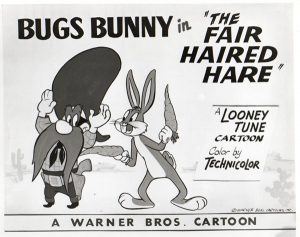 Life in legal “wedlock” just isn’t suiting for either Bugs or Yosemite. As the two settle down to bed and the lights go out, Yosemite sneaks across the room in the shadows, armed with a mallet. Bugs flicks on the light just before Sam reaches him, and Sam covers for his wielding the implement by hammering at the floor, claiming that the “carpet keeps rolling up.” The light switch is pulled again, and Sam again steals across the room. A “Pow” is heard, and the lights come on. Now Bugs is in possession of the mallet, and a battered Yosemite staggers back across the room. “There”, says Bugs, “That oughta keep that carpet flat.” Next morning, Sam fixes breakfast, including carrot juice – but adds a drop to one glass from a bottle marked with a skull and crossbones, producing a violent chemical reaction, and melting the stirring spoon. He places respective glasses upon a rotating “lazy susan” style breakfast table, inviting Bugs to drink up – “It’s hood fer ya”. Without warning, Bugs spins the table a half turn, calling out, “Trade ya.”. “Drink yer own juice”, insistes Sam, rotating the table back a half turn. Bugs gives the table a stronger spin, setting it into countless revolutions. “Round she goes, where she stops, nobody knows.” Sam’s eyes dizzily attempt to keep track of whose glass is whose, until he finally grabs the table, putting the brakes on the spin. “Cut it out”, he demands, and orders Bugs to drink his glass at gunpoint. Bugs refuses unless Sam drinks his first. Believing he has guessed right as to which glass is spiked, Sam grins and says “It’s a deal”, and downs his glass, then raises his pistols again at Bugs. Now nervous, Bugs lifts the glass with trembling hands, and swallows its contents. To his pleasure, he smacks his lips, compliments that it was delicious, and asks for seconds. Yosemite’s eyes shrink to mere dots in fright, as the chemicals take effect, launching him like a rocket through the roof, over the horizon as seen through the porch winsow, and produce an atomic explosion against the sunrise. Blackened but still black-hearted, Sam races back, guns at the ready. Bugs lifts the bearskin rug and disappears into his rabbit hole. Sam obtains a seemingly endless supply of dynamite sticks and gunpowder, stuffing sticks and barrels into the rabbit hole. Bugs grabs each one as it enters the hole, evenly distributing them underneath the floorboards of Sam’s house. When the hole seems packed (one stomp makes the flooring bulge with the red of the hidden explosives), Sam lights a fuse, but fails to leave the center of the blast. The resulting explosion leaves nothing on the ground but a crater, in the center of which sands the boundaries of Bugs’ rabbit hole, unscathed. Bugs looks up to see the cabin soaring endlessly into the stratosphere. Yosemite, clinging to a porch post, assesses the situation, and is not entirely displeased with the result, as he observes, “Well, what d’ya lnow? I got me a cabin in the sky!”
Life in legal “wedlock” just isn’t suiting for either Bugs or Yosemite. As the two settle down to bed and the lights go out, Yosemite sneaks across the room in the shadows, armed with a mallet. Bugs flicks on the light just before Sam reaches him, and Sam covers for his wielding the implement by hammering at the floor, claiming that the “carpet keeps rolling up.” The light switch is pulled again, and Sam again steals across the room. A “Pow” is heard, and the lights come on. Now Bugs is in possession of the mallet, and a battered Yosemite staggers back across the room. “There”, says Bugs, “That oughta keep that carpet flat.” Next morning, Sam fixes breakfast, including carrot juice – but adds a drop to one glass from a bottle marked with a skull and crossbones, producing a violent chemical reaction, and melting the stirring spoon. He places respective glasses upon a rotating “lazy susan” style breakfast table, inviting Bugs to drink up – “It’s hood fer ya”. Without warning, Bugs spins the table a half turn, calling out, “Trade ya.”. “Drink yer own juice”, insistes Sam, rotating the table back a half turn. Bugs gives the table a stronger spin, setting it into countless revolutions. “Round she goes, where she stops, nobody knows.” Sam’s eyes dizzily attempt to keep track of whose glass is whose, until he finally grabs the table, putting the brakes on the spin. “Cut it out”, he demands, and orders Bugs to drink his glass at gunpoint. Bugs refuses unless Sam drinks his first. Believing he has guessed right as to which glass is spiked, Sam grins and says “It’s a deal”, and downs his glass, then raises his pistols again at Bugs. Now nervous, Bugs lifts the glass with trembling hands, and swallows its contents. To his pleasure, he smacks his lips, compliments that it was delicious, and asks for seconds. Yosemite’s eyes shrink to mere dots in fright, as the chemicals take effect, launching him like a rocket through the roof, over the horizon as seen through the porch winsow, and produce an atomic explosion against the sunrise. Blackened but still black-hearted, Sam races back, guns at the ready. Bugs lifts the bearskin rug and disappears into his rabbit hole. Sam obtains a seemingly endless supply of dynamite sticks and gunpowder, stuffing sticks and barrels into the rabbit hole. Bugs grabs each one as it enters the hole, evenly distributing them underneath the floorboards of Sam’s house. When the hole seems packed (one stomp makes the flooring bulge with the red of the hidden explosives), Sam lights a fuse, but fails to leave the center of the blast. The resulting explosion leaves nothing on the ground but a crater, in the center of which sands the boundaries of Bugs’ rabbit hole, unscathed. Bugs looks up to see the cabin soaring endlessly into the stratosphere. Yosemite, clinging to a porch post, assesses the situation, and is not entirely displeased with the result, as he observes, “Well, what d’ya lnow? I got me a cabin in the sky!”
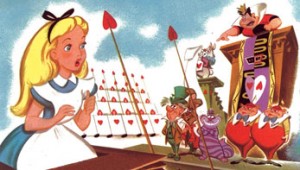 Alice In Wonderland (Disney/RKO, 7/26/51) of course inherits a set-piece from the Lewis Carroll original of Alice’s trial before the King and Queen of Hearts. About a year before, stop-motion animator Lou Bunin, for his live-action/animation mix version of the same project, had played the trial rather straight and by-the-book. The Disney writers, on the other hand, again try to pull out all the stops for their terrific voice cast of Kathryn Beaumont, Verna Felton, Ed Wynn, Jerry Colonna, Sterling Holloway, and Dick Trout. The White Rabbit dramatically sets the mood with a herald’s trumpet as the judges, litigants and jury enter the royal courtroom. The White Rabbit graciously addresses all classes of persons present (nearly forgetting to include in his greeting the insignificant King). He begins reading off a long and convoluted list of charges against “the prisoner at the Bar” (Alice), getting hung up on loads of legal jargon. (Charges in this version have nothing to do with stolen tarts, but center on disrupting the croquet game.) The impatient Queen chastises the rabbit: “Never mind that! Get to the part where I lose my temper!” The rabbit obliges, speeding so fast to the end of his parchment that he drops the scroll. “Are you ready for your sentence?”, the Queen asks Alice, with a treacherous toothy grin. Alice protests that there must be a verdict. “Sentence first – Verdict afterward” replies the Queen. “But that isn’t the way” retorts Alice, only to be reminded by the red-faced Queen that all ways here are the Queen’s way. As the Queen gets halfway through her trademark roar of “OFF WITH HER…..”, her minuscule husband begs that just for fun, they call one or two witnesses. “Oh, all right”, begrudges the Queen, “BUT GET ON WITH IT!” The witness list includes the March Hare, Dormouse, and Mad Hatter. March Hare’s statement that he knows “Nothing whatever” is treated by the court and jury as vital testimony – and of even more import is the Dormouse’s half-asleep recitation of “Twinkle Twinkle Little Bat”. The Mad Hatter says he was home at the time of the crime celebrating his unbirthday. The King observes that it’s the Queen’s unbirthday, too – and suddenly the court erupts in a gala celebration over the anniversary of nothing. Amidst this madness appears the Cheshire Cat, hiding as the “velvet” lining of the new crown the Queen receives for a present. He scares the Dormouse, whose panic can only be stopped by applying jam on his nose. “The jam! Let me have it!” shouts the Queen – and promptly gets the pot in her face. Somebody’s head is going to roll for this – and it’s Alice’s! From here, the plot gets back on track from the book, with Alice using the mushroom to grow a “mile high”, but its effects wearing off, and the whole pack of the Queen’s card soldiers chasing her madly through Wonderland back to the real world.
Alice In Wonderland (Disney/RKO, 7/26/51) of course inherits a set-piece from the Lewis Carroll original of Alice’s trial before the King and Queen of Hearts. About a year before, stop-motion animator Lou Bunin, for his live-action/animation mix version of the same project, had played the trial rather straight and by-the-book. The Disney writers, on the other hand, again try to pull out all the stops for their terrific voice cast of Kathryn Beaumont, Verna Felton, Ed Wynn, Jerry Colonna, Sterling Holloway, and Dick Trout. The White Rabbit dramatically sets the mood with a herald’s trumpet as the judges, litigants and jury enter the royal courtroom. The White Rabbit graciously addresses all classes of persons present (nearly forgetting to include in his greeting the insignificant King). He begins reading off a long and convoluted list of charges against “the prisoner at the Bar” (Alice), getting hung up on loads of legal jargon. (Charges in this version have nothing to do with stolen tarts, but center on disrupting the croquet game.) The impatient Queen chastises the rabbit: “Never mind that! Get to the part where I lose my temper!” The rabbit obliges, speeding so fast to the end of his parchment that he drops the scroll. “Are you ready for your sentence?”, the Queen asks Alice, with a treacherous toothy grin. Alice protests that there must be a verdict. “Sentence first – Verdict afterward” replies the Queen. “But that isn’t the way” retorts Alice, only to be reminded by the red-faced Queen that all ways here are the Queen’s way. As the Queen gets halfway through her trademark roar of “OFF WITH HER…..”, her minuscule husband begs that just for fun, they call one or two witnesses. “Oh, all right”, begrudges the Queen, “BUT GET ON WITH IT!” The witness list includes the March Hare, Dormouse, and Mad Hatter. March Hare’s statement that he knows “Nothing whatever” is treated by the court and jury as vital testimony – and of even more import is the Dormouse’s half-asleep recitation of “Twinkle Twinkle Little Bat”. The Mad Hatter says he was home at the time of the crime celebrating his unbirthday. The King observes that it’s the Queen’s unbirthday, too – and suddenly the court erupts in a gala celebration over the anniversary of nothing. Amidst this madness appears the Cheshire Cat, hiding as the “velvet” lining of the new crown the Queen receives for a present. He scares the Dormouse, whose panic can only be stopped by applying jam on his nose. “The jam! Let me have it!” shouts the Queen – and promptly gets the pot in her face. Somebody’s head is going to roll for this – and it’s Alice’s! From here, the plot gets back on track from the book, with Alice using the mushroom to grow a “mile high”, but its effects wearing off, and the whole pack of the Queen’s card soldiers chasing her madly through Wonderland back to the real world.
A short adjournment until next week, to allow time for preparation and filing of supplemental briefs.


 Charles Gardner is an animation enthusiast who toils by day as a member of LA Law – but by nights and weekends indulges in classic jazz and ragtime as a performer; and studies classic Hollywood cartoons… maybe a little too much.
Charles Gardner is an animation enthusiast who toils by day as a member of LA Law – but by nights and weekends indulges in classic jazz and ragtime as a performer; and studies classic Hollywood cartoons… maybe a little too much.



































































































































































I know “The Fair Haired Hare” violates every law of physics and logic — but Friz never studied law!
Seeing “Musica-Lulu” and the excerpt from “Alice in Wonderland” in the same post reminds me of the 1925 children’s novel “Alice in Orchestralia” by Ernest LaPrade. A little girl named Alice falls asleep at an orchestra concert and descends down the bell of the tuba into a land of living musical instruments. My own instrument, the viola, is portrayed as a morose pessimist, rather like the character Glum in the old “Adventures of Gulliver” cartoons, who does nothing but grumble and sulk until the cello snaps at him: “You haven’t the spirit of an asthmatic mouth organ!” I consider this an ethnic slur.
“Alice in Orchestralia” was a popular book in its time, heavily promoted by musical societies. By the forties it had been adapted into a radio series and a record album, so it may have been an inspiration for Lulu’s dream sequence in that cartoon. Nice job on the reconstruction, by the way.
It’s “A minor” point, but “G” whiz: The members of the vocal quartet that you’ve identified as “quarter notes” are actually eighth notes — or, as we in Commonwealth countries call them, crotchets and quavers, respectively. The absurd lengths some people will go to to avoid learning their fractions.
The mad queen in ALICE IN WONDERLAND shouting, “OFF WITH HER HEAD!” scared the yell out of me as a kid.
Here’s a much better looking copy of A Mutt in a Rut.
https://www.youtube.com/watch?v=ZG32azQizU0